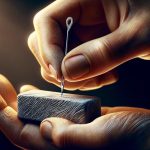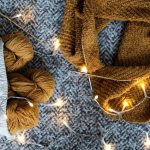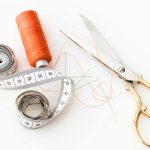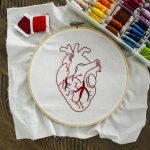When you're embarking on your embroidery journey, having the right tools can make all the difference in achieving professional results. You might think any needle or thread will do, but specific choices can elevate your work significantly. From selecting the ideal needles to choosing the right stabilizers and accessories, the right combinations can streamline your process and enhance your creativity. Curious about which tools will truly set you up for success? Let's explore the essentials that can transform your embroidery experience.
Table of Contents
Key Takeaways
- Use a universal needle for general embroidery; select smaller or larger sizes for detailed or heavy fabrics, respectively.
- Choose high-quality polyester or cotton threads that match your fabric for optimal strength and finish.
- Select the appropriate hoop or frame type to enhance project stability and ease of design application.
- Utilize the right stabilizer based on fabric type and design density to maintain shape and achieve a professional look.
Essential Embroidery Needles
When you're diving into embroidery, having the right needles makes all the difference in achieving clean and precise stitches.
You'll want to start with a selection of needle types tailored to your projects. For general embroidery, the universal needle is your best friend; it's versatile and works well with most threads and fabrics.
If you're focusing on finer details, opt for a smaller needle, like a size 9 or 10. These needles glide effortlessly through lightweight fabrics and allow you to create delicate designs.
For heavier fabrics, such as denim or canvas, a larger needle, like a size 14 or 16, will help pierce through layers without breaking.
Don't forget about specialty needles! A ballpoint needle is perfect for knits, while a sharp needle features a larger eye to accommodate thicker threads. Always keep your needle clean and replace it often; a dull needle can lead to frustration and uneven stitches.
Choosing the right needle isn't just about aesthetics; it also impacts the overall quality of your work.
With the right tools in hand, you're well on your way to beautiful embroidery projects.
Quality Embroidery Threads
Quality embroidery threads can significantly enhance the vibrancy and durability of your designs, making them essential for any stitching project. Choosing the right thread can make a world of difference, whether you're working on a delicate floral pattern or a bold monogram.
When selecting threads, consider the material. Polyester threads are known for their strength and resistance to fading, while cotton threads offer a soft, natural finish. You'll want to match the thread type to your fabric to achieve the best results.
Also, pay attention to the thread weight. Thicker threads can create striking, textured designs, while finer threads are perfect for intricate details.
Don't forget to check the colorfastness of your threads. You want colors that won't bleed or fade after washing. Investing in high-quality threads not only improves your final product but also makes your stitching experience more enjoyable.
Lastly, always store your threads properly to prevent fraying and tangling. By prioritizing quality embroidery threads, you'll elevate your projects and ensure they stand the test of time, showcasing your hard work and creativity beautifully.
Versatile Hoops and Frames
A versatile hoop or frame is essential for keeping your fabric taut and ensuring precision in your embroidery projects. With the right tools, you can tackle a variety of designs with ease. Whether you're working on small patches or large banners, having the appropriate size and type of hoop makes a world of difference.
Here's a quick comparison of different types of hoops and frames:
| Type | Best For |
|---|---|
| Round Hoops | Small designs and details |
| Square Hoops | Larger pieces and quilts |
| Snap Frames | Quick changes and adjustments |
| Magnetic Hoops | Easy repositioning |
| Embroidery Frames | Heavy fabrics and stability |
Choosing the right hoop or frame not only improves your technique but also enhances the overall outcome of your embroidery. You'll find that using the appropriate tools reduces the likelihood of puckering and distortion, which can occur with improper tension. So, invest in versatile hoops and frames that suit your projects, and watch your embroidery skills flourish.
Stabilizers for Perfect Results
Choosing the right stabilizer can make all the difference in achieving flawless embroidery results. Stabilizers provide the support your fabric needs during the stitching process, preventing puckering and distortion.
There are three main types of stabilizers: cutaway, tear-away, and wash-away.
Cutaway stabilizers are perfect for stretchy fabrics, as they provide lasting support. They stay under the stitches, ensuring your design maintains its shape even after multiple washes.
Tear-away stabilizers are great for stable fabrics. They're easy to remove, leaving a clean finish.
Wash-away stabilizers are ideal for delicate projects, as they dissolve in water, leaving no residue behind.
When selecting a stabilizer, consider the fabric type, the density of your design, and how much stability is needed. Always test your stabilizer on a scrap piece of fabric to see how it interacts with your materials.
Don't be afraid to experiment with different stabilizers for various projects; you might find the perfect match that enhances your embroidery.
Helpful Embroidery Accessories
What embroidery accessories can elevate your crafting experience and ensure smoother project execution? The right tools can make all the difference.
First, consider a good pair of embroidery scissors. These small, sharp scissors are perfect for snipping threads and achieving clean edges.
Next, a magnetic needle holder can keep your needles organized and easily accessible, saving you the hassle of searching through your supplies.
Another essential accessory is a thread organizer. With a dedicated space for each type of thread, you'll avoid tangling and wasting time.
A quality seam ripper is also a must-have; it can help you easily correct mistakes without damaging your fabric.
Don't overlook the benefits of a needle threader, especially when working with fine threads. It speeds up the process and reduces frustration.
Frequently Asked Questions
How Do I Choose the Right Fabric for Embroidery?
To choose the right fabric for embroidery, consider its weight, texture, and fiber content. You'll want a fabric that can hold stitches well, like cotton or linen, while ensuring it complements your design's details.
Can I Wash Embroidered Items, and How?
Yes, you can wash embroidered items! Use cold water and a gentle cycle to prevent damage. If possible, turn the item inside out and air dry to maintain the design's integrity and vibrant colors.
What Are the Best Ways to Store Embroidery Supplies?
To store your embroidery supplies, use clear containers for visibility, organize threads by color, and keep tools in a dedicated drawer. Label everything so you can easily find what you need when inspiration strikes.
How Do I Fix Mistakes in My Embroidery?
When you spot mistakes in your embroidery, don't panic! Carefully unpick the stitches using a seam ripper, re-thread your needle, and re-stitch the area. Practice patience, and your piece will look great again!
Is Machine Embroidery Different From Hand Embroidery?
Yes, machine embroidery and hand embroidery are different. Machine embroidery uses a sewing machine to create designs quickly, while hand embroidery involves stitching by hand, allowing for more intricate details and personal expression in each piece.
- Jaclyn Smith Fabric Coconut: a Review of This Rayon/Polyester Blend - June 29, 2025
- Jaclyn Smith Fabric Coconut: a Review of This Rayon/Polyester Blend - June 29, 2025
- How to Get Coconut Oil off Fabric Without Washing - June 29, 2025







